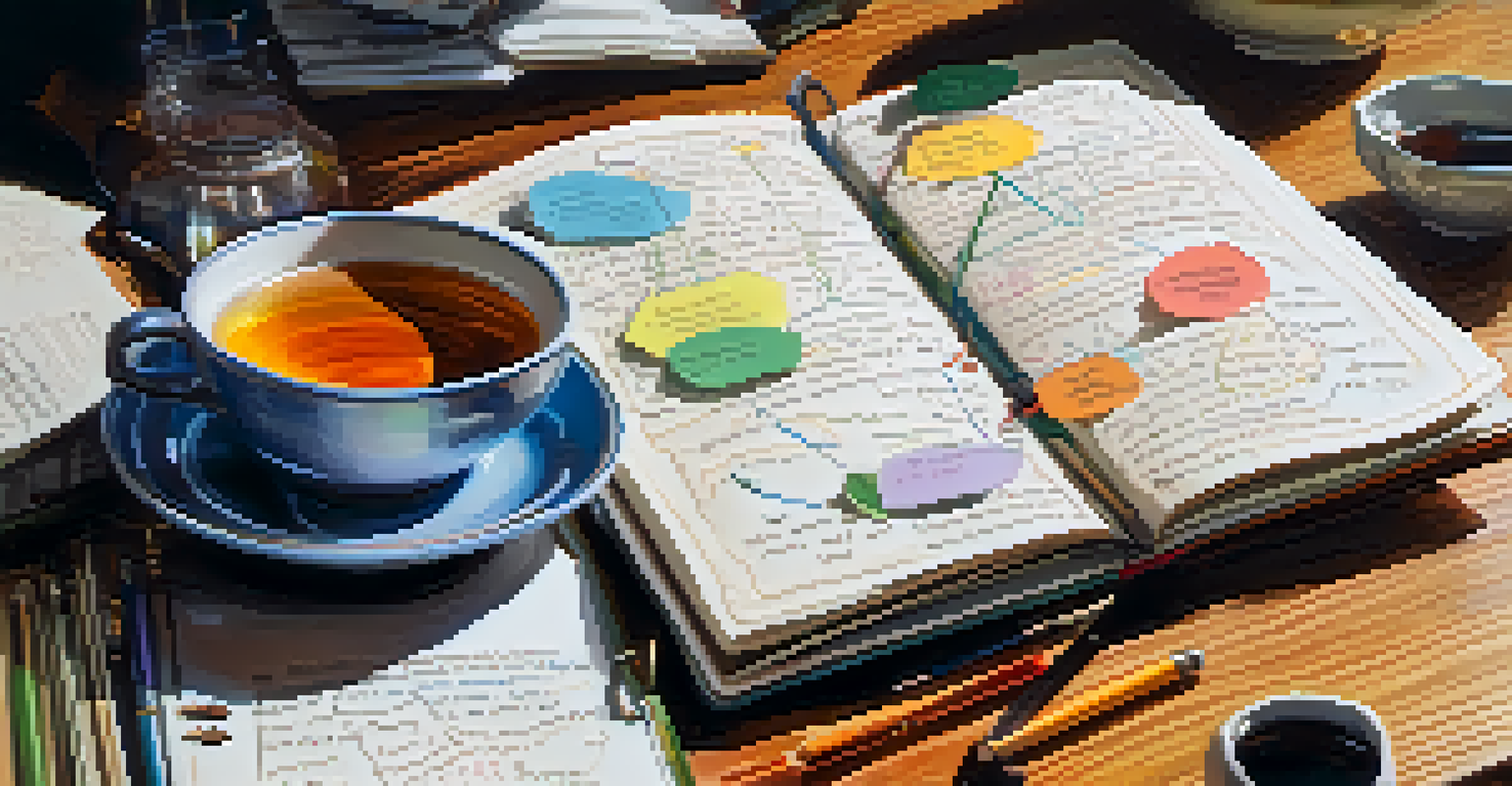Reading and Memory: Techniques to Retain What You Read

Understanding the Connection Between Reading and Memory
Reading isn't just about decoding words; it's also about how our brains process and retain information. When we read, we engage multiple cognitive functions that help us understand and remember what we've read. This connection is crucial because the way we approach reading can significantly impact our ability to recall details later.
Reading is to the mind what exercise is to the body.
For instance, consider how we remember stories as children. The vivid imagery and emotions tied to those tales make them stick in our minds. Similarly, creating mental images while reading complex material can enhance memory retention, turning abstract concepts into relatable scenarios.
Ultimately, recognizing this relationship between reading and memory can guide us in adopting strategies that improve our retention of information, making our reading sessions not just more enjoyable but also more fruitful.
Active Reading: Engaging with the Text
Active reading involves interacting with the material instead of passively absorbing it. This could mean underlining key points, making notes in the margins, or summarizing sections in your own words. By doing so, you create a dialogue with the text, which fosters deeper understanding and recall.

Think of it like having a conversation with a friend. The more you engage, ask questions, and respond, the more you remember the nuances of that conversation. This principle applies to reading as well; the more actively you engage, the better you’ll retain the information.
Active Reading Enhances Retention
Engaging with the text through techniques like underlining and note-taking fosters deeper understanding and better recall.
Incorporating active reading strategies can transform your reading experience from a chore into a dynamic and memorable activity, ultimately leading to a better grasp of the material.
The Power of Note-Taking for Retention
Taking notes is a proven technique that can significantly boost memory retention. When you write down key ideas, you’re not just recording information; you’re processing it in a way that makes it easier to remember later. This method allows you to summarize and distill complex concepts into digestible chunks.
The more that you read, the more things you will know. The more that you learn, the more places you'll go.
Imagine preparing for a test: reviewing handwritten notes can often spark memories more effectively than skimming through a book. This is because the act of writing helps reinforce neural pathways in your brain related to that information.
Ultimately, whether you prefer digital or traditional pen-and-paper notes, using this technique can make a substantial difference in how well you remember what you've read.
Mind Mapping: Visualizing Information for Better Recall
Mind mapping is a creative and visual way to organize information, making it easier to understand and remember. By creating a diagram that connects ideas, you can see the relationships between concepts at a glance. This technique appeals to visual learners who may struggle with linear note-taking methods.
Think of mind mapping as creating a roadmap of your thoughts. It allows you to visualize how information interlinks, making it easier to retrieve later. This approach can be particularly helpful when reading complex materials that involve various themes or arguments.
Visual Aids Boost Memory Recall
Using methods like mind mapping helps organize information visually, making it easier to understand and remember.
Incorporating mind mapping into your reading routine can help solidify your understanding and memory, transforming abstract information into a structured visual format.
Repetition and Review: Reinforcing Memory
One of the oldest tricks in the book for improving memory is repetition. The more often you encounter and review information, the more likely it is to stick. This could involve re-reading sections or discussing what you've learned with others.
Consider how you might remember a song after hearing it multiple times. Our brains thrive on repetition, and this principle can be applied to reading as well. Revisiting material at spaced intervals helps reinforce memory, making the information more accessible over time.
Incorporating a regular review schedule into your reading practice can significantly enhance your retention, ensuring that what you've read stays fresh in your mind.
Utilizing Mnemonics for Better Retention
Mnemonics are memory aids that can help you recall complex information through simpler associations. These can take many forms, such as acronyms, rhymes, or visual imagery. By creating these mental shortcuts, you make it easier to remember details that might otherwise be challenging to retain.
For example, if you're trying to remember a list of items, you could create a silly sentence where each word starts with the same letter as the items on your list. This playful approach not only makes learning fun but also more effective.
Repetition Reinforces Learning
Regularly reviewing material strengthens memory retention, ensuring that information stays fresh in your mind.
Using mnemonics can be an enjoyable way to strengthen your memory, turning the often tedious process of memorization into a creative challenge.
The Role of Environment in Reading Retention
Your reading environment plays a crucial role in how well you retain information. A quiet, comfortable space with minimal distractions can help you focus better on the text. Conversely, a noisy or chaotic environment can impede your ability to absorb and remember what you read.
Think of it as trying to listen to a podcast while in a bustling café. It's much harder to concentrate and remember the details compared to sitting in a quiet room. Creating a conducive reading environment can enhance your comprehension and retention significantly.

By being mindful of where and how you read, you can optimize your learning experience and improve your memory retention.
Putting It All Together: A Reading Strategy for Retention
Combining these techniques into a cohesive reading strategy can maximize your retention and comprehension. Start by choosing a quiet space, engage actively with the text, take notes, and use mind maps where applicable. Incorporating repetition and mnemonics will further solidify what you learn.
Think of this strategy as a recipe: each ingredient plays a vital role in the final dish. By blending these techniques, you create a robust approach to reading that not only enhances retention but also makes the process more enjoyable.
Incorporating these methods into your reading routine can transform your experience, allowing you to retain and recall information with ease and confidence.